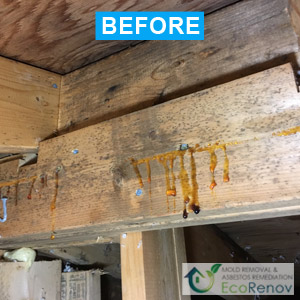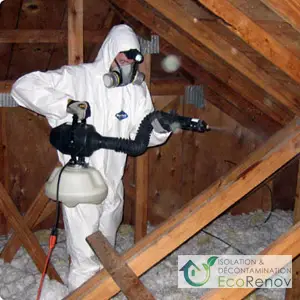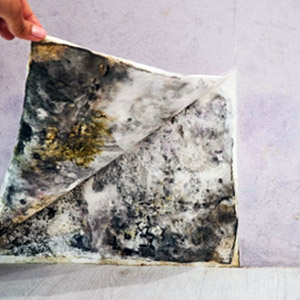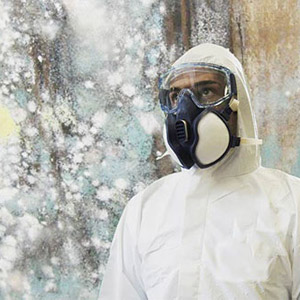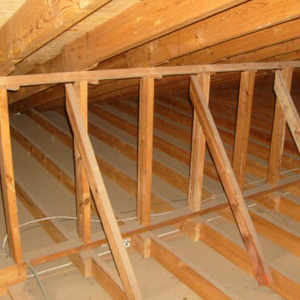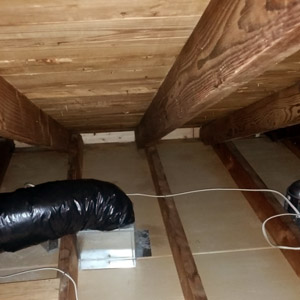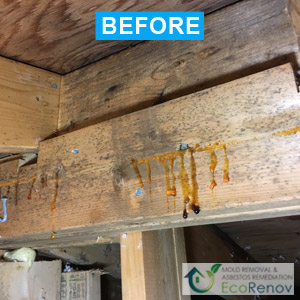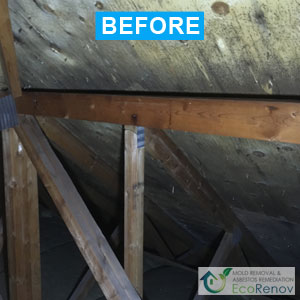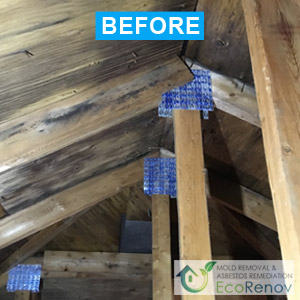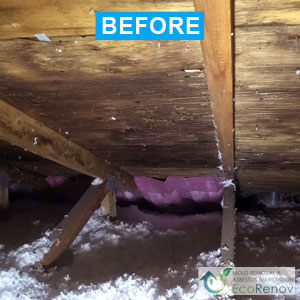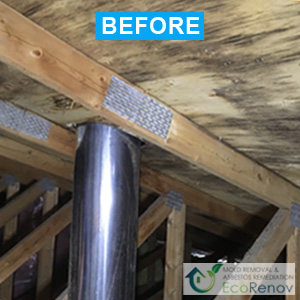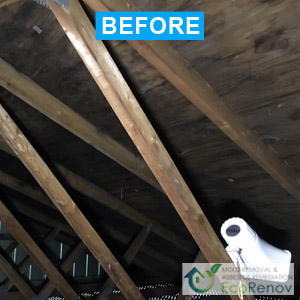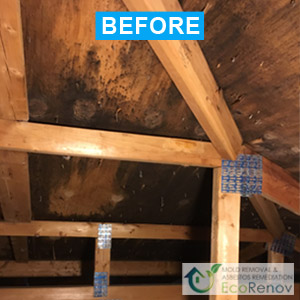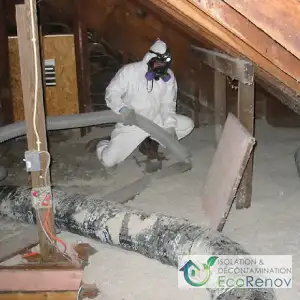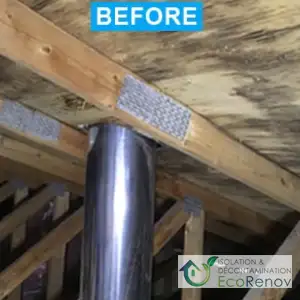Had water damage in your basement and wondering what to do? Don’t panic! Every minute counts, and with the right actions and the help of professionals, you can minimize the damage and protect your home from this basement water damage.

First, it’s important to know that mold spores are present in the air both inside and outside your home at all times. Now, when a basement experiences water damage, the construction materials get wet, and it only takes 24-48 hours for mold spores to latch on and start developing. To prevent this from happening, here are a few steps that can help you regain control of the situation:
1. Empty the contents and demolish
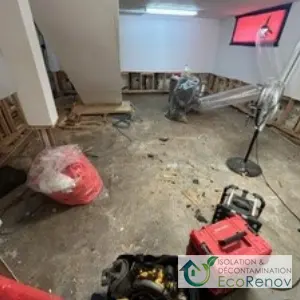
- Try to remove your belongings (e.g., furniture, boxes, shoes, etc.) as quickly as possible. Movers may be required if needed.
- Reason 1: Items that absorbed humidity from the basement water damage and are porous will develop mold (e.g., legs of an Ikea furniture, cardboard boxes, mattresses on the floor, etc.)
- Reason 2: These items absorb humidity from the surrounding air. So, when you attempt to dehumidify the basement, it’s important that your dehumidifiers work to remove moisture from the construction materials and not from contents like wooden furniture, boxes, and winter coats, for example, that you store in the basement.
- Quickly remove all porous materials affected by the basement water damage, such as:
- Remove the moldings that were wet at the bottom of the wall (replacement cost is low and they are very porous).
- Remove drywall (gypsum) that has more than 19% moisture.
- When you open your lower walls, try to make straight cuts (e.g., using a guide such as a piece of plywood) according to the following predefined heights:
- Height of 12″, 16″, 24″, or 48
- The above heights will facilitate reconstruction, as you will only need to cut a drywall sheet into 1, 2, 3, or 4 pieces lengthwise.
- Here are 2 useful tools to help you determine the height at which to open the drywall or preserve and dry it.
- When you open your lower walls, try to make straight cuts (e.g., using a guide such as a piece of plywood) according to the following predefined heights:
- The carpets ;
- Floating floors and the vapor barrier underneath;
- Warning! If these materials are not removed in time (within 24 to 48 hours) after water damage, they can trap humidity, leading to mold growth and worsening structural damage.
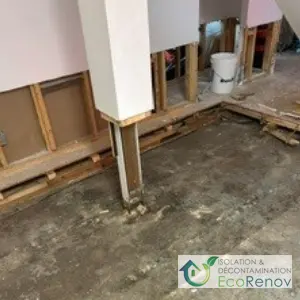 What to do if the materials were not removed within 24 to 48 hours after water damage? (working in the presence of mold)
What to do if the materials were not removed within 24 to 48 hours after water damage? (working in the presence of mold)- First, if you plan to do the work yourself, it is important to wear appropriate safety gear;
- Next, install a vapor barrier plastic at the entrance of the basement (at the top of the stairs) to isolate the contaminated area from the rest of the house.
- Install a fan that will expel air through a window in the basement, and apply polyethylene plastic to seal the window frame, leaving only a round hole for the back of your fan.
- The idea is for the air from the basement to exit through the window, not for air to come in through the window.
- To check if your setup is working well (ref.: creating negative pressure in the basement), the vapor barrier plastic will bulge inward when negative pressure is established.
- Do not operate bathroom fans, kitchen fans, etc., on the upper floors;
- You can operate bathroom fans and other types of fans in the basement to create an air exchange system for the basement.
- Do not heat the room in an attempt to dehumidify. Instead, use efficient dehumidifiers and fans. Here is a list of suggestions:
- If you detect mold odors, you can use this type of air purifier
Call us at 438-800-2046 now, and we can quickly send a team to begin the demolition as soon as possible. When it comes to water damage, time is of the essence to salvage as many materials as possible and preserve your living environment upstairs.
Ask For A Free Quotation Now!
438-800-2046

Water Damage in Basement:
Ask for advice now!
Ask for advice now!
2. Once the demolition is complete – dry the remaining materials
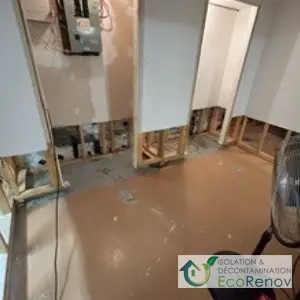
- Use fans, dehumidifiers, and air conditioning systems, if available, to dry the basement;
- Ensure that everything is completely dry before moving on to step 3 (construction materials such as wood and drywall must be dry and below 19% humidity).
- The relative humidity should be kept as low as possible in the basement, ideally below 50%. Additional dehumidifiers may be required.
- The best practice, somewhat like billiards, is to use the dry air from the dehumidifiers and have it ricochet with the fans to dehumidify the most humid areas.
- If you detect odors, you can use an air purifier like this one, which you can keep for future use (the cost of replacement filters is low)
- Here are 2 useful tools to help you measure the humidity level in materials and in the basement:
3. Cleaning and Mold Removal
- Vacuum all debris from contaminated construction areas and perform a thorough cleaning to keep the site ‘clean’.
- You can use products such as Mold Control to clean floor tiles, freezers, refrigerators, and other non-porous surfaces that have been affected by water damage.
- Above all, do not use solutions containing bleach. This could accelerate mold development.
For concrete and wood framing, you will need to rely on professionals who have access to products not available over the counter. Call us at 438-800-2046 for a free estimate.
4. Reconstruction
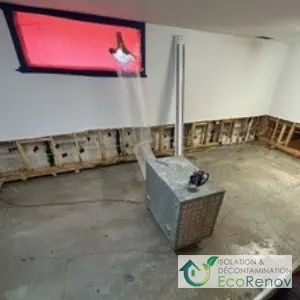 Before starting the reconstruction work following water damage in the basement;
Before starting the reconstruction work following water damage in the basement;- Ensure that the relative humidity in the room is maintained steadily below 50%;
- Materials such as wood framing and drywall must be below 19% moisture (Non-Invasive Moisture Meter// Pin-Type Moisture Meter).
- The concrete slab and walls must be dehumidified to the maximum. The desired humidity level is a bit too technical to explain here, but ensure that the concrete appears dry and uniform to the naked eye. If you can maintain the relative humidity below 50%, it may indicate that the concrete is no longer ‘saturated’ with water.
- Consult a local general contractor for the reconstruction and ensure that insulation and rebuilding are done to code, and complete the work before the cold weather arrives.
In the event of water damage in the basement, it is essential to act quickly and methodically to limit damage and protect your home. By following the outlined steps, you increase your chances of avoiding long-term complications such as mold or structural damage. Remember that each situation is unique, and it may be wise to call professionals at 438-800-2046 to ensure everything is handled correctly.
Related to Basement Water Damage and Mold
Ask for a Price Quote for Your Basement Demolition/Mold Removal Project


Mold Removal Services, Water Damage in Basement (per area)
Mold Removal, Laval
Mold removal, Laval: you live in Laval and have just discovered the presence of mold in your property. Indeed, the situation is worrying, but fear not, it is possible to have local professional mold removal services in Laval without breaking the bank. At Mold Removal & Asbestos Remediation EcoRenov, [...]
Mold Removal, Montreal
Mold Removal in Montreal: have you discovered a mold problem in your home? Know that it is possible to obtain professional, certified and safe mold removal services in Montreal at a very affordable price. In fact, Mold Removal & Asbestos Remediation EcoRenov offers to the Greater Montreal region a [...]
Mold Removal, Longueuil
Recognized for our mold removal services in Longueuil, our team of mold removal experts offers you the most complete range of mold related services, a professional and safe approach at the best price in town. Whether it is for mold removal in the attic, in the basement or in [...]
Mold Removal, Rosemere
For mold removal work in Rosemere, Mold Removal & Asbestos Remediation EcoRenov is your one-stop shop where you will find the largest range of professional mold removal & remediation services. Thanks to our many years of experience in mold removal, we have developed an effective, targeted and safe approach [...]
Mold Removal, Repentigny
Mold removal, Repentigny. Working in the Repentigny's area, the EcoRenov’s team offers you a complete, certified and safe mold removal & remediation services at the best price in town. We know that it is always worrying to find the presence of mold in our home, but do not worry, [...]
Mold Removal, Terrebonne
Mold removal, Terrebonne: a mold problem in a house is an abnormal situation which can be stressful and very worrying, but know that everything can be corrected at the best price in town. At Mold Removal & Asbestos Remediation EcoRenov, we have understood for a long time that in [...]
Mold Removal, Blainville
Mold removal in Blainville: for all mold problems in Blainville, Mold Removal & Asbestos Remediation EcoRenov places an experienced team in mold removal & remediation at your disposal. We offer the most complete range of mold removal services allowing you to: Obtain a turnkey service in mold removal from [...]
Attic Decontamination, Chateauguay
For attic decontamination in Chateauguay, EcoRenov is your contractor of choice. We take pride in providing comprehensive decontamination services, focusing on addressing underlying issues such as mold removal in the attic, attic and roof ventilation, attic insulation, and vermiculite removal in the attic. Mold in the attic in Chateauguay [...]
Mold Removal Cost, Dorval
The costs of mold removal are essentially based on 2 main variables, i.e. 1) the costs associated with correcting the causes at the origin of the mold outbreak (e.g. repairing a crack in the foundation, repairing a leaking roof, increased attic ventilation, etc.) and 2) direct costs associated with [...]

